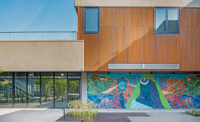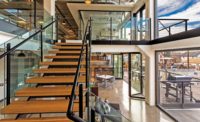Congress Square
Boston
Best Project and Project of the Year Finalist
Owner: Related Beal
Lead Design Firm: Arrowstreet
General Contractor & Construction Manager: Consigli Construction Co.
Civil Engineer: Nitsch Engineering Inc.
Structural Engineer: McNamera / Salvia Inc.
Geotechnical Engineering: Haley Aldrich
Bracing & Shoring: Thornton Tomasetti
MEP Code: Cosentini
Historic Preservation: Tremont Preservation Services
Working with limited info from original drawings and having limited access for field verification were ongoing challenges for this complex project that transformed five interconnected historic buildings into a modern urban campus.
“The project had unique challenges in an existing building,” one judge said.
The more than 343,000-sq-ft structure, delivered on time and within budget in 32 months, comprised major renovations and additions to three of the five buildings—repurposing them into one new commercial office building with a seven-story vertical glass addition constructed on top of what is now 33 Congress. Crews built the new superstructure on 14 steel transfer columns, which connect to the concrete core and 2,000 tons of structural steel framing around the core.
In building the addition, the team says it juggled partially dismantling three separate yet interconnected buildings with different geometries and grid lines while deciding which structure to preserve. The team shored the original building facades and structure from roof down to three levels below the street where crews installed mini-pile foundations to support the new central elevator core and seven-story addition.
“They saved a piece of history, at least a facade, and kept the vibe of that entire historic area and built a new building inside it … visually it’s a very nice project,” said another judge.
After demolition began, the team discovered the carbon content of the existing buildings’ riveted steel was too high for accepting welded steel connection. The team conducted detailed laser scanning of all the existing steel to allow fabricators to engineer the new steel to properly attach to the existing steel using mechanical fastening instead of welding. By using a 3D model of a new steel connection onto the scan data for review by the engineer of record, the team was able to streamline field modifications by the steel contractor.
After demolition was completed at the core, the steel fabricator laser scanned all existing beams. For each connection of new steel to old, a custom-engineered bolted connection was necessary, the team says. Assuring the steel was fabricated to a custom fit required close collaboration with the design team.
Many unexpected conditions were revealed during structural dismantling and demolition, requiring the team to work together to find solutions. When the team found the steel layout and framing differed from what was found on the historic drawings, they had to continuously verify all historic structures that would remain and make adjustments to the field conditions. This required verifying all steel locations within each building and at the existing roof parapet to ensure steel would be properly located and accomplish the design intent. The team incorporated this info into 3D building information models.
To support the vertical addition, the team constructed a modern concrete core to consolidate the existing building’s many elevators. As separate buildings were connected, they threaded the core through an existing light well at the center of the building.
The team constructed a 1,700-sq-ft, seven-elevator core mat foundation and 14 perimeter pile caps in the basement to prepare for the addition. It also threaded 14 supercolumns down through the existing buildings to support the vertical addition. Crews were often left with only 8 ft to 12 ft of headroom from the drill rig, which required “significant adaptations” by the pile-driving team, the team says.
Making room for the concrete mat slab and core wall was also challenging. The team says an 80-ft by 80-ft opening was cleared from the top of the building down to the basement, which required 800 truckloads of material to be hauled out.
To preserve historic features of the original building, the team restored existing brass grillwork in the lobby, repaired and restored existing patinated copper cornice at the top of the existing building and installed new copper flashing and a patina green thermoplastic polyolefin (TPO) membrane to upgrade the parapet construction to today’s weatherproofing standards while preserving the cornice’s historic character.
Back to "New England's 2019 Top Regional Work Sets High Standards"











Post a comment to this article
Report Abusive Comment